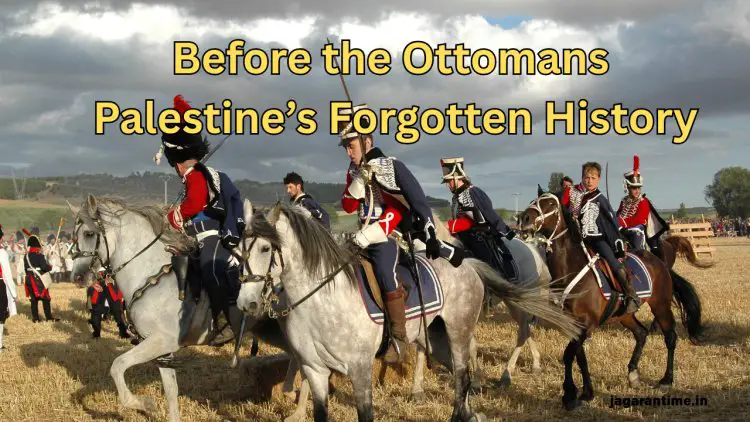Who Lived in Palestine Before the Ottoman Empire? A Deep Dive into Ancient History
Who ruled Palestine before the Ottomans? Discover the Canaanites, Israelites, Romans, Byzantines, and early Islamic rulers who shaped the land's deep-rooted past.

Palestine, a region central to the histories of three major religions—Judaism, Christianity, and Islam—has long been a cradle of civilizations. While much of modern political discourse focuses on the Israeli-Palestinian conflict or the Ottoman Empire’s long rule, the question remains: Who lived in Palestine before the Ottomans took control in 1516?
In this detailed article, we explore the complex and fascinating layers of history that unfolded in Palestine long before the Ottomans. From the Canaanites to the Romans, Byzantines to Islamic caliphates, many powers rose and fell over this sacred and strategic land.
Canaanites: The Earliest Settlers (Before 3000 BCE)
- The earliest known inhabitants of Palestine were the Canaanites, a Semitic people who settled in the region as early as 3000 BCE.
- They developed urban centers like Jericho and Megiddo, practiced agriculture, and worshipped a pantheon of deities.
- Canaanite culture flourished for centuries and interacted with Egyptian and Mesopotamian empires via trade routes.
Israelite and Jewish Kingdoms (1200–586 BCE)
- Around 1200 BCE, Israelites began settling in the region, eventually forming the Kingdoms of Israel and Judah.
- Under kings like David and Solomon, Jerusalem became a political and religious center.
- The First Temple was built in Jerusalem but was destroyed in 586 BCE by Nebuchadnezzar, king of Babylon.
Babylonian and Persian Rule (586–332 BCE)
- After destroying the Jewish kingdom, the Babylonians exiled many Jews to Babylon.
- In 539 BCE, Cyrus the Great of Persia conquered Babylon and allowed Jews to return and rebuild Jerusalem's temple (Second Temple Period).
- This era was relatively tolerant and allowed local governance under Persian imperial oversight.
Greek (Hellenistic) Period (332–63 BCE)
- Alexander the Great conquered Palestine in 332 BCE, introducing Hellenistic (Greek) culture.
- Following Alexander's death, his generals fought over the territory, and control shifted between the Ptolemies (Egypt) and Seleucids (Syria).
- Jewish resistance led to the Maccabean Revolt and the formation of the Hasmonean Kingdom, a brief period of Jewish autonomy.
Roman Rule (63 BCE–324 CE)
- General Pompey of Rome took control of Jerusalem in 63 BCE, turning the region into a Roman client state.
- Under Herod the Great, massive building projects flourished, including an expansion of the Second Temple.
- The life and crucifixion of Jesus of Nazareth occurred during this period under Roman rule.
- In 70 CE, Romans destroyed the Second Temple during a Jewish revolt, changing the religious landscape forever.
Byzantine Period (324–638 CE)
- After the Roman Empire adopted Christianity, Palestine became part of the Byzantine Empire.
- Many churches were built, including the Church of the Holy Sepulchre in Jerusalem.
- Jews and other non-Christian communities faced restrictions.
- This era was marked by theological and cultural Christian dominance.
Islamic Conquest and Rule (638–1099 CE)
- In 638 CE, Muslim armies led by Caliph Umar conquered Jerusalem peacefully.
- Umayyads and later Abbasids ruled the land from Damascus and Baghdad.
- Iconic Islamic structures like the Dome of the Rock and Al-Aqsa Mosque were built on the Temple Mount.
- The region prospered under Islamic rule, with a tolerant policy toward Christians and Jews as "People of the Book."
Crusader and Ayyubid Period (1099–1291 CE)
- In 1099, European Crusaders captured Jerusalem during the First Crusade, establishing the Kingdom of Jerusalem.
- Their rule was marked by religious persecution and conflict.
- Saladin, the famous Muslim general, retook Jerusalem in 1187, restoring Islamic control.
- The Ayyubids, founded by Saladin, encouraged the return of Muslims and Jews to the city.
Mamluk Rule (1291–1516 CE)
- The Mamluks, originally slave-soldiers who became rulers of Egypt, took control of Palestine after defeating the Crusaders.
- They ruled the region from Cairo and maintained religious sites and trade routes.
- While politically decentralized, they emphasized Islamic scholarship and architecture.
The Ottoman Takeover (1516)
- In 1516, Sultan Selim I of the Ottoman Empire defeated the Mamluks and incorporated Palestine into the empire.
- Thus began 400 years of Ottoman rule, but as this blog focuses on the pre-Ottoman era, we conclude our historical exploration here.
Summary Table of Rulers Before the Ottomans:
|
Period |
Rulers/Empires |
Key Events |
|
3000 BCE+ |
Canaanites |
Early urban civilization |
|
1200–586 BCE |
Israelites/Jewish Kingdoms |
First Temple built |
|
586–332 BCE |
Babylonian & Persian Empires |
Exile and Second Temple construction |
|
332–63 BCE |
Greeks (Ptolemies & Seleucids) |
Hellenization, Maccabean revolt |
|
63 BCE–324 CE |
Roman Empire |
Jesus' life, Second Temple destroyed |
|
324–638 CE |
Byzantine Empire |
Christianization of region |
|
638–1099 CE |
Islamic Caliphates |
Islamic architecture, tolerance |
|
1099–1291 CE |
Crusaders & Ayyubids |
Christian-Muslim battles |
|
1291–1516 CE |
Mamluk Sultanate |
Stability and cultural growth |
Palestine’s history before the Ottoman Empire is a tapestry woven from the threads of multiple civilizations—each leaving a profound impact on the land. From the Canaanite settlements to the Jewish kingdoms, from Roman conquests to Islamic Caliphates, and from Crusader rule to Mamluk governance, the land has continuously been reshaped by the tides of history. Understanding this background is crucial to comprehending the region’s present-day complexity.
Disclaimer:
This article is intended for informational purposes only. The historical facts provided here are based on commonly accepted academic sources and should not be interpreted as political commentary. Readers are encouraged to explore additional scholarly resources for deeper understanding.













